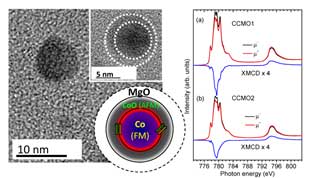The exchange bias occurs when a ferromagnetic material (FM) and an antiferromagnetic material (AFM) get in touch and, as a result, there is a strong magnetic interaction between them. This effect has a great impact on magnetic recording systems and contributed to a better understanding for producing smaller computer hard disks with a higher information density.
Researchers designed and produced samples consisting of Co/CoO core-shell nanoparticles (~4 nm diameter Co metal core and CoO shell with ~1 nm thickness) embedded in a non-magnetic MgO matrix. This system exhibits a surprisingly large exchange bias field HE≈ 2460 Oe and a large coercive field HC ≈ 6200 Oe at T= 2K, which is in sharp contrast to the small exchange bias and coercive field in the case of a non-magnetic Al2O3 or C matrix materials reported in previous studies.
Using the brilliant circular polarized soft x-rays of the BOREAS beamline, at the ALBA Synchrotron, they measured the soft x-ray magnetic circular dichroism (SXMCD) of the samples and a ferromagnetic signal originating from the nominally antiferromagnetic CoO shell could be observed. This finding gives direct evidence for the existence of rotatable interfacial uncompensated Co spins in the CoO shell, thus supporting the uncompensated spin model as a microscopic description of the exchange bias mechanism.
This research, which has been developed within the framework of a BOREAS in-house research project, is accepted and will be published in Nanoscale ("Direct observation of rotatable uncompensated spins in the exchange bias system Co/CoO–MgO" Chuannan Ge, Xiangang Wan, Eric Pellegrin, Zhiwei Hu, S. Manuel Valvidares, Alessandro Barla, Wen-I. Liang, Ying-Hao Chu, Wenqin Zou and Youwei Du (2013) DOI: 10.1039/ C3NR02013D).
Figure 1. Samples analyzed at the BOREAS beamline. The samples consisted of a ~4 nm diameter Co metal core and a CoO shell with ~1 nm thickness. The red zone shows the magnetic interaction area between FM Co core and the AFM CoO shell, where the "exchange bias" effect takes place.





